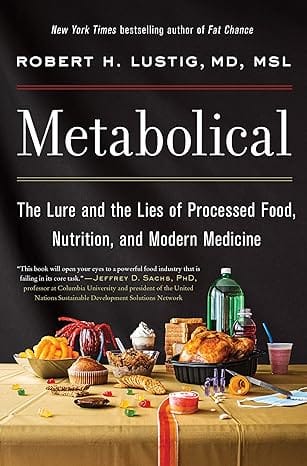Book Review: Metabolical
A good book about the perils of sugar and ultra-processed food. Metabolical offers Dr Robert Lustig's insights about what makes for a healthy diet.

A good book about the perils of sugar and ultra-processed food.
The book Metabolical by Dr Robert Lustig, a renowned researcher and endocrinologist, gives us an informed overview of the current challenges with the American diet and why it may be detrimental to your health. Some practical tips can be found in my previous post A Healthy Diet?. This book review will contain more details about Dr Lustig’s thinking and philosophy.
The Core Argument: Processing Matters More Than Ingredients
The core premise of Metabolical is that it’s not what’s in the food that matters, but what’s been done to the food. This is exactly where those who pay close attention to ingredients may still find themselves struggling with their diet. In perhaps the starkest case of this, Dr Lustig argues that fruit smoothies are actually very unhealthy.
The act of blending the fruit to make the smoothie removes fiber and makes it far easier for you to ingest. Whole fruit contains sugar, but it is wrapped in protective fiber. This has 2 benefits: the first is that fiber is generally good for your gut. Second, it delays the uptake of sugar reducing any potential insulin spike.
The Insulin Connection: A Key to Understanding Metabolic Health
Insulin spikes are bad:
[I]nsulin resistance occurs when the cells in your muscles, fat, and liver no longer respond to the insulin signal. The glucose can’t get in—the cells are starving—so they send signals to the pancreas to crank out even more, but to no avail. The glucose builds up in your blood at the same time that your cells are starving, adding insult to injury. You’ll see that it’s this condition that is the underlying cause of most of our troubles.
From the book review of Outlive, insulin resistance is the core driver of metabolic syndrome. In that longer book review we go into more detail about how metabolic syndrome is often the driving cause behind many of the diseases of civilization (cardiovascular, cancer, neuro-degeneration, and directly diabetes).
Practical Advice: Navigating Food Choices
Dr. Lustig recommends using the NOVA food classification system to guide our choices:
- Unprocessed or minimally processed foods
- Processed culinary ingredients
- Processed foods
- Ultra-processed foods
He emphasizes choosing foods from group one - items without labels, like fresh fruits and vegetables. Additionally, he offers a simple rule of thumb: if any of the first three ingredients on a label are sugar, consider that product a dessert. This perspective can be eye-opening, revealing that seemingly healthy options like Trader Joe's Beef and Broccoli or Chinese Chicken Salad are essentially desserts in disguise.
Beyond specific food choices, increasing your intake of fiber (especially non-soluble) will go a long way to preventing overeating.
If you’re a parent, there are also studies linking the effects of sugar to poor academic performance, increased ADHD and other disciplinary issues. Dr Lustig notes:
More and more young people are developing metabolic syndrome earlier. Adolescents with metabolic syndrome demonstrate cognitive decline and greater impulsivity. When you scan them, they exhibit white matter lesions, smaller hippocampi (the memory center), and reduced prefrontal cortex mass (the executive function center).
Metabolic syndrome (via sugar) is literally causing brain damage.
Understanding the prevalence of sugar in our available, processed foods is very important to improving your diet. Dr Lustig spends some time explaining why the food industry is so eager to add sugar:
Sugar adds bulk. Kellogg’s Honey Smacks are 56 percent sugar. ’Nuff said?
Sugar makes food brown. Indeed, we love the brown color and caramel taste.
Sugar raises the boiling point. This allows for caramelization to occur, which like we said is very tasty, but again this is just the Maillard reaction, which, over time, can cause your cells to age.
Sugar is a humectant (attracts and maintains moisture). How soon does fresh bakery bread become stale? Maybe two days? How about grocery store commercial bread? More like three weeks. Ever wonder why? In commercial bread, the baker adds sugar to take the place of water, known as water activity.
Sugar is a preservative. Have you ever left a soda at room temperature? Of course, after the carbonation escapes, it goes flat. But do bacteria or yeast ever grow in it? Never.
Taking Action: Improving Your Diet
To improve your diet based on these insights:
- Focus on NOVA class 1 foods – whole, minimally processed foods
- Increase your fiber intake, especially non-soluble fiber
- Be mindful of hidden sources of sugar, especially in packaged food
- Choose food that’s hard to over-eat, like raw almonds or carrots
- Consider the glycemic load of foods to understand how it could affect your blood sugar
Conclusion
Dr Lustig ends his book with a provocative quote:
Once upon a time, you would walk down the street, see someone smoking, and think they were cool and hip. Today you see someone smoking and feel pity for them. I believe that ten years from now, you’ll walk down the street, see someone drinking a Coca-Cola, and feel pity for them as well.
This perspective on food challenges us to rethink what we know about a healthy diet. Metabolical provides a useful guide offering both scientific explanation and advice. By learning these lessons we can make better choices about our nutrition.
Note: Dr Lustig has given many interviews that are available on YouTube. It’s possible he has interacted with your favorite health podcaster! This is one of his most famous talks, which has turned into this book.
Some quotes I really liked from the book:
You drink a soda. The tongue sends a signal to the hypothalamus that says, “Hey, sugar is coming, get ready to metabolize it.” The hypothalamus then sends a signal along the vagus nerve to the pancreas, saying, “A sugar load is coming, get ready to release the insulin.” If the “sweet” signal is from a diet sweetener, the sugar never comes. What happens next? Does the pancreas say, “Oh, well . . . I’ll just chill until the next meal,” or does it say, “WTF? I’m all primed for the extra sugar. Let’s eat more to get it.”
A quick analysis of Heinz ketchup gives pause. Yes, tomato concentrate is listed as the first ingredient, then vinegar, and then high-fructose corn syrup (HFCS) and corn syrup are numbers three and four. When you look at the calories (20 kcal) versus the carbohydrate content of 5 grams (4 of which are sugar) multiplied by 4 calories/gram, you realize that tomatoes may be the plurality, but not the majority of the ingredients.



